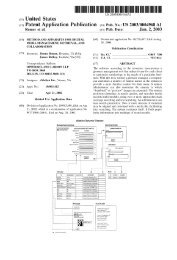Polaroid Corp. v. Eastman Kodak Co. - Oppedahl Patent Law Firm LLC
Polaroid Corp. v. Eastman Kodak Co. - Oppedahl Patent Law Firm LLC
Polaroid Corp. v. Eastman Kodak Co. - Oppedahl Patent Law Firm LLC
Create successful ePaper yourself
Turn your PDF publications into a flip-book with our unique Google optimized e-Paper software.
Intellectual Property Library ISSN 1526-8535<br />
many amateur photographers were loyal to <strong>Kodak</strong>, many <strong>Kodak</strong> purchasers were anti-<br />
<strong>Polaroid</strong> and, most importantly, a large group viewed the <strong>Kodak</strong> name as a "reassurance<br />
or risk-reducing mechanism" which legitimized, and therefore made attractive, the instant<br />
photography field. (TR 8161). Professor Buzzell based this conclusion partly upon<br />
contemporaneous market research which tried to identify why consumers bought instant<br />
cameras.<br />
There is no doubt that <strong>Kodak</strong> is a well-known brand and that the <strong>Eastman</strong> <strong>Kodak</strong><br />
<strong>Co</strong>mpany has a fine reputation. There is also no dispute that <strong>Polaroid</strong> is known the world<br />
over as a photographic company of first quality. Were the <strong>Kodak</strong> name and reputation<br />
somehow critical to consumers' decisions to purchase instant photography?<br />
To answer this question, Professor Buzzell cited several small, unstructured studies of<br />
<strong>Kodak</strong> and <strong>Polaroid</strong> instant purchasers which contained some statements that <strong>Polaroid</strong><br />
and <strong>Kodak</strong> were perceived differently and that corporate image influenced the decision to<br />
buy instant. However, the record is devoid of any convincing evidence that the <strong>Kodak</strong><br />
brand name was critical to a meaningful number of consumers who chose instant.<br />
In one such study, Stage One, a marketing consulting group hired by <strong>Polaroid</strong>, conducted<br />
one-on-one in-depth interviews with two small samples of camera owners: thirty-two<br />
OneStep/Pronto! owners and twenty-two <strong>Kodak</strong> Instamatic owners in 1978, and twentynine<br />
<strong>Kodak</strong> Handle purchasers in 1979. At most, this study showed that some instant<br />
purchasers perceived <strong>Kodak</strong> and <strong>Polaroid</strong> differently. Some <strong>Kodak</strong> buyers thought that<br />
<strong>Kodak</strong> was more for the "man on the street" and <strong>Polaroid</strong> did not make cameras "for me."<br />
However, this type of random statement conflicted with other findings in the study; for<br />
example, both <strong>Kodak</strong> and <strong>Polaroid</strong> purchasers gave the same reasons for the appeal of<br />
instant photography. (DF 20,776).<br />
Other studies mentioned by Professor Buzzell contained similar conflicts and no<br />
conclusive evidence. An October 1976 demonstration tested alternative versions of the<br />
Pronto!, EK4, and EK6, and concluded that when ranking the importance of various<br />
features in selecting a camera, reliability was rated number one, followed by value for<br />
money, simplicity of operation, and ease of use. Brand was considered the least<br />
important reason for choosing a particular camera, followed by appearance, weight, and<br />
size.<br />
Professor Dolan, <strong>Polaroid</strong>'s marketing expert, and Professor Buzzell's colleague at the<br />
Harvard Business School, also considered the question of whether <strong>Kodak</strong>'s name and<br />
reputation were a major structural factor which influenced demand during the<br />
infringement period. While he admitted that for some loyal <strong>Kodak</strong> customers, <strong>Kodak</strong>'s<br />
entry was the impetus for purchasing an instant camera, there were not meaningful<br />
numbers of these people. Like Professor Buzzell, Professor Dolan based his conclusions<br />
on market research. These conclusions, however, were buttressed with his analysis that<br />
the instant camera market did not need legitimizing by a well-known company because<br />
<strong>Polaroid</strong> was also well-known and trusted, especially in the field of instant photography.<br />
Moreover, Professor Dolan opined that legitimization is more likely when consumers<br />
themselves are unable to judge the quality of the product. This is not the case in the field<br />
of instant photography. I agree and adopt Professor Dolan's analysis as confirmation of<br />
the fact that the <strong>Kodak</strong> brand name did not expand demand for instant photography.<br />
Even with its small sample and unstructured methodology, one finding which stands out<br />
from the Stage One study is that ninety-three percent of <strong>Kodak</strong> purchasers had negative<br />
<strong>Co</strong>pyright 2003, The Bureau of National Affairs, Inc. Reproduction or redistribution, in<br />
whole or in part, and in any form, without express written permission, is prohibited except<br />
as permitted by the BNA <strong>Co</strong>pyright Policy. http://www.bna.com/corp/index.html#V<br />
24





